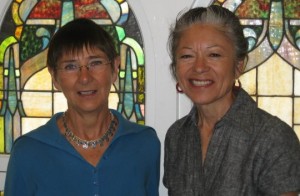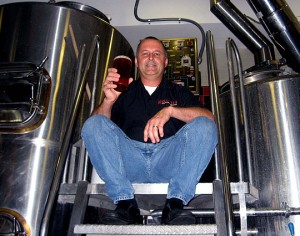
Anna Kokotovic, left, former executive director of CALM (Child Abuse Listening & Mediation), gave new Executive Director Cecilia Rodriguez her start with the organization more than 20 years ago. (Jennifer Guess photo)
Starting as a volunteer in 1984, CALM‘s (Child Abuse Listening & Mediation) new Executive Director Cecilia Rodriguez has proven her passion for protecting children from abuse. Now she wants to focus on prevention, reaching out to young families to help break the cycle of abuse.
Leslie Dinaberg: So you started as a volunteer at CALM?
Cecilia Rodriguez: Yes, when my own children were very little and I was trying to get away from my life as a full time mom. I wanted to be able to talk about something more than diapers and baby stuff, which is fine but when I got involved here at CALM as a volunteer, within minutes I realized that this was what I would do for the rest of my life. That’s why I warn volunteers when they come here, I say “beware this agency has a way of grabbing you.” The mission is just so compelling and we’re protecting the most vulnerable in our community and helping families to grow and change and break the cycle of abuse.
LD: So you went graduate school and became a marriage and family therapist.
CR: Yes and Dr. Anna Kokotovic, the executive director at the time, offered me a position doing intensive in-home therapy, doing treatment at people’s homes, in the streets, in schools. Wherever families hung out, that’s where I hung out.
… The wonderful thing about in-home work is that you really get a much clearer picture of what’s going on than you do when they come to the office. You rely here on what they tell you, but when you go there and you see the conditions that they are living under, the stressors that they are facing, the challenges, and the poverty. Then you realize that some of the things we innocently ask people to do in their homes are just not possible. So we have to adapt it so that it’s something that really will work for them.
LD: How willing are people to have this kind of an intervention of people coming into their homes?
CR: I am always so humbled–and I’m going to start crying because I always cry about this–that people trust us enough to allow us to come into their home. I am always so touched by that, and it just shows you the level of distress that they’re in, or they are seeking so much, they want support.
LD: What programs are you emphasizing now?
CR: … My focus now, as executive director, is to focus more on prevention than on trying to repair the problem after it has occurred. With teenagers it would be so much better not to get to that place. That’s why we’re really emphasizing preschool, emphasizing preschool aged children aged 0 to 5, the younger the better. And it’s not the children we’re focusing on, it’s the parents so that we can support them to be better families, to listen to their children to be supported themselves. You know, a lot of parents haven’t been supported, didn’t get optimum family situations and so they just repeat what was done. If in their family they were raised in a really punitive family environment, they will tend to do the same thing unless we can intervene. … We try to target young families, even before they have their babies. We get referrals from obstetricians and pediatricians and the Public Health Department when there are certain risk factors and then we begin working with them on bonding and attachment issues from day one.
…We have a whole team of home visitors called Great Beginnings, and they are the ones that go to homes of the very young children.
LD: You have a lot of different programs and a lot of things going on, but what is your perception of the needs of Santa Barbara County versus what you’re able to provide.
CR: Well, there’s always more need than we’re able to provide and again, the need is I think, because I’ve been doing this for a lot of years, and I’m tired of coming in after the fact when abuse has happened and then we react by wrapping our CALM services around the family. That’s why I want to focus on support and prevention efforts, teaching parents how to be better parents and families how to be there for one another. There are so many stressors in families’ lives these days and it’s getting even more challenging now, financial stressors, our economy, that’s adding another, and our families have always been stressed in that way because we work often with families of lower social economic class, so it’s always challenging for them, but then it’s even more challenging now.
LD: Obviously, there are people that have higher risk backgrounds than others, but in some ways everybody has that potential to go too far.
CR: Right. We all have the capacity to abuse given a certain set of circumstances, given certain life stressors I think we can, like you say, cross the line or lose sight of what we’re supposed to do with our children.
LD: In addition to earlier, is there anything else that you feel like is a shift from what’s been done in the past?
CR: Support for preschools. That’s also where I see that children who are experiencing neglect or are growing up in stressful situations where they are exposed to domestic violence, they are not ready to learn; they’re not ready for kindergarten. You know kids are getting kicked out of preschool, this is shocking to me … If you can’t make it in preschool oh my gosh. But you know, when kids are aggressive that’s an automatic “we can’t deal with you here” because they hurt other children. And not every preschool does that, kicks kids out, but there are some, and we see kids here who can’t make it in preschool setting. It is sad. So what we’re doing is we’re partnering with, for instance, Storyteller, and we’re offering support to children and the teachers so that we can help these children to be successful so they’re ready on day one in kindergarten they are ready to learn.
LD: That’s really important.
CR: Yes because what happens if they’re not ready and they’re disruptive from day one they get tagged, you know these kids they get tagged, even in preschool, as the problem kids and they’re going to be problem, problem, problem and they’re going to fail in school.
LD: That’s really sad.
CR: This is a great fact that I uncovered the other day. Do you know that our volunteers provide us with 10,000 hours a year of volunteer time? We have volunteers provide childcare. What our families tell us is one of the most helpful things that we do. When they come here for an appointment they can bring their kids and the kids will be taken care of.
LD: When you’re not working what do you like to do?
CR: I am a total gym rat. I’m an exercise junkie. I go to the Goleta Valley Athletic Club. What’s really important about this work is that it can be very stressful work, of course, you can take a lot home with you, and self-care is very important and I try to model that for the staff. We really stress the importance of when you’re not here when you’re not working, surrounding yourself with beauty, with culture, with laughter, good books, whatever it is that feeds your soul, that’s what you need to do when you’re not here.
So I work out because I’m a fanatic about it, just because it makes me feel good, and also I’m a gardener, My garden is my pride and joy. I love my garden so I’m always out there in my garden. And I have a really solid family, which also helps.
Vital Stats: Cecilia Rodriguez
Born: Los Angeles, November 25, 1957
Family: Husband Bob Stanley; two grown children, Tom who lives in Bellingham, WA, and Clare, who lives in Granada, Spain.
Professional Accomplishments: Art Teacher at Marymount in the 1970s, staff member at CALM for more than 22 years.
Best Book You’ve Read Recently: Kabul Beauty School by Deborah Rodriguez
Little-Known Fact: “I love Cheetos. That is my junk food of choice. About every six months I have a Cheetos attack and I just totally give into it.”








